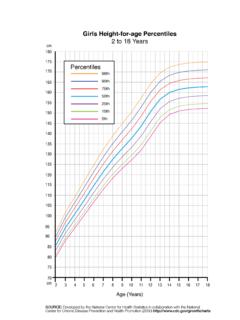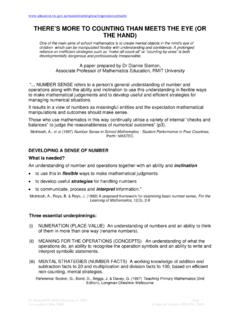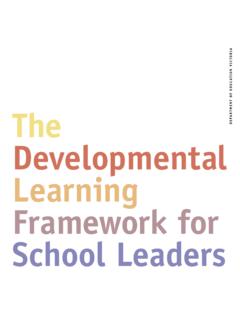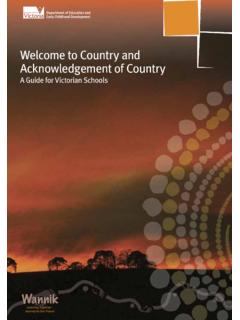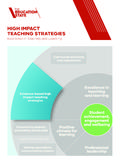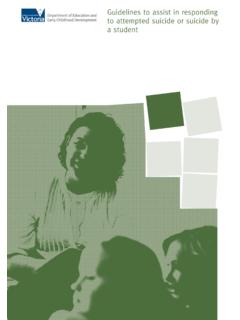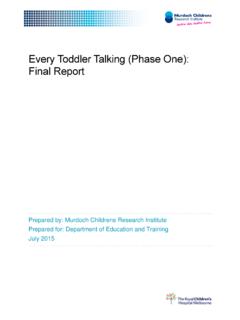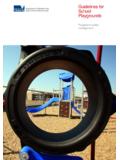Transcription of LITERACY AND NUMERACY STRATEGY
1 LITERACY AND NUMERACY STRATEGY VERSION 12 | The Education StatePublished by the Department of Education and TrainingMelbourne June 2017 State of Victoria (Department of Education and Training) 2017 The copyright in this document is owned by the State of Victoria (Department of Education and Training), or in the case of some materials, by third parties (third party materials). No part may be reproduced by any process except in accordance with the provisions of the Copyright Act 1968, the National Education Access Licence for Schools (NEALS) (see below), or with educational institution situated in Australia which is not conducted for profit, or a body responsible for administering such an institution may copy and communicate the materials, other than third party materials, for the educational purposes of the by the Department of Education and Training, 2 Treasury Place, East Melbourne, Victoria, 3002. ISBN: 978-0-7594-0800-5 LITERACY and NUMERACY STRATEGY : Version 1 | 3 ContentsSecretary s Foreword 5 Why LITERACY and NUMERACY ?
2 6 LITERACY and NUMERACY in the Education State 8 Why now? 10 What is the LITERACY and NUMERACY STRATEGY ? 12 Principles and expectations 12 Timelines 14 Strategic focus and summary of actions 18 Support for our teachers 20 Support for all 20 Additional support for selected schools 23 Support for our school leaders 24 Support for all 24 Additional support for selected schools 24 Implementation and impact 26 Shaping the STRATEGY
3 274 | The Education State LITERACY and NUMERACY STRATEGY : Version 1 | 5 It gives me great pleasure to introduce the Education State: LITERACY and NUMERACY STRATEGY . This STRATEGY has been developed to respond to your needs, and at the request of the Minister for Education, The Hon. James Merlino, Victoria, you have been working hard to lift the LITERACY and NUMERACY achievement of the children and young people in your classrooms and communities. Your excellent results are making a real difference to their you know, LITERACY and NUMERACY are foundational to engagement in education and lifelong achievement. Strong LITERACY and NUMERACY help us to learn, experiment, reason and create, to be active and informed citizens, and to contribute socially, culturally and economically. Our understanding of, and the demands of, LITERACY and NUMERACY teaching and learning are greater today than ever before. Success in LITERACY and NUMERACY for our students involves creating, interpreting and communicating.
4 It also requires understanding, reasoning, authentic problem-solving and building resilience and collective challenge is to ensure that every student in Victoria is able to benefit from this focused effort. We want all of our young people to reach their full potential, including in LITERACY and NUMERACY . This means lifting as an entire system. In every classroom, in every school, every teacher and every principal has a role to play in this STRATEGY . So too do networks, regions and central office. We will work together to join the system up to support you. This is what it will take to lift outcomes for every student. We know this is possible from looking at successful local and international examples. And we know we have significant strengths in our system to build on, as articulated by people at every level of that system. You have told us that to help you in your work with all of your students, you want easily accessible, high quality, and differentiated LITERACY and NUMERACY support.
5 This includes the provision of evidence-based, detailed guidance on LITERACY and NUMERACY leadership and teaching. This is why we are introducing the Excellence in Teaching and Learning: A School Leaders Guide to Improving LITERACY and NUMERACY Outcomes. Detailed but not prescriptive, the Guide sets out the structures, processes, and deliberative practices that have already been shown to work in Victoria and elsewhere to lift LITERACY and NUMERACY leaders and teachers, we are also providing High Impact Teaching Strategies - to further support excellence in teaching and learning. These strategies are recognisable, key instructional practices used in every day teaching, which will support stronger outcomes across all learning areas, including LITERACY and NUMERACY . This STRATEGY sets out how system-wide success in LITERACY and NUMERACY will come from fully drawing on our existing Education State foundations including the FISO. This means having a strong focus on LITERACY and NUMERACY at all levels of the system; delivery of detailed information and guides for schools and teachers to help them assess and teach most effectively; and additional support tailored to school need.
6 The STRATEGY is all about bringing together the ability to assess students progress with evidence-based teaching and whole-school actions. Through the Panorama reports and other school-based data, we now have the capacity to work out where students, classes and schools can improve. There are children and young people in classrooms and schools across Victoria who urgently need us to work together more effectively to support their LITERACY and NUMERACY learning. For them, the window to realising their full potential is either opening or closing, right now. I commit that as part of this STRATEGY we will maintain this sense of urgency. We will draw on and learn from the great work that is already happening in Victoria and elsewhere. We will continue to refine this STRATEGY and develop its implementation with you. And we will keep bringing ourselves back to the critical question: what can we each do to make the biggest difference to the learning of children and young people? We will develop and implement this STRATEGY with you.
7 The support outlined in this document will be tested in practice through engagement forums, networks, and regional teams. Your ideas and knowledge will shape both the implementation and further iterations of the STRATEGY . I thank you for your professionalism and your hard am pleased to be able to offer you this strategic approach to LITERACY and NUMERACY to accelerate the work we are all doing for the benefit of Victorian children and young Callister SecretarySecretary s Foreword6 | The Education StateA strong foundation in LITERACY and NUMERACY is vital for every child and young person, and underpins their ability to engage in education, reach their potential, and to participate fully in the community. This contributes to a virtuous circle, in which characteristics such as the ability to reason critically, to experiment, and to be resilient and persistent also support the development of LITERACY and is why strong LITERACY and NUMERACY outcomes for all children and young people are a key part of the Education State goals and targets, including Learning for life and Breaking the link, alongside and supporting Happy, healthy and resilient kids and Pride and confidence in our schools.
8 In the Education State, we care deeply about LITERACY and NUMERACY , but we don t care only about LITERACY and and young people need increasingly sophisticated levels of language and mathematics in order to take care of their health and wellbeing, participate in the workforce and make a positive contribution to a democratic society. Mathematics supports us to analyse and reason about the nature of the world. Language enables us to communicate effectively, which is vital to feeling connected to the people around us. LITERACY and NUMERACY underpin the acquisition of more complex skills. For example, making the transition from learning to read to reading to learn provides children with opportunities to engage with the entire school curriculum, including critical and creative thinking, social sciences, STEM subjects (science, technology, engineering and mathematics) and the arts. This is also the case for children who make the transition from learning to write to writing for academic success.
9 An understanding of numbers and a robust knowledge of mathematical concepts enables children and young people to make connections between related ideas and to progressively apply their understanding in new and unfamiliar contexts. As young people enter high school, they need to develop more specific LITERACY and NUMERACY capabilities so that they can access the curriculum across the disciplines they study. We all know that there is a world of difference between the life and prospects of a student who is not meeting minimum standards, a student who is in the lowest bands of NAPLAN, and a student who is in the top two bands. Strong LITERACY and NUMERACY supports student engagement and achievement, completion of Year 12 and tertiary education, and employment and higher income all of which are also associated with better health and less involvement with the justice system. Today, more than ever before, the consequences of not having strong LITERACY and NUMERACY are substantial.
10 The ability to tell opinion from fact, to understand a changing environment, to connect with others within and beyond our community, and to do meaningful work in a global and increasingly automated economy all require a citizenry with higher levels of LITERACY and NUMERACY . Why LITERACY and NUMERACY ? LEARNING FOR LIFEHAPPY, HEALTHY & RESILIENT KIDSBREAKING THE LINKPRIDE & CONFIDENCE IN OUR SCHOOLSMore students excel in scientific literacyMore students excel in the artsMore students develop strong critical and creative thinking skillsMore students will be physically activeReduce the impact of disadvantageMore students stay in education for better pathwaysMore students excel in reading and mathematicsRaise the levels of community pride and confidence in Victorian government schoolsMore students will be resilientLiteracy and NUMERACY STRATEGY : Version 1 | 7 That s why, as part of a suite of holistic targets, we have committed to ambitious LITERACY and NUMERACY targets as part of the Education State reforms: 25 per cent more Year 5 students will reach the highest levels of achievement in reading and maths by 2020; 25 per cent more Year 9 students will reach the highest levels of achievement in reading and maths by 2025.
